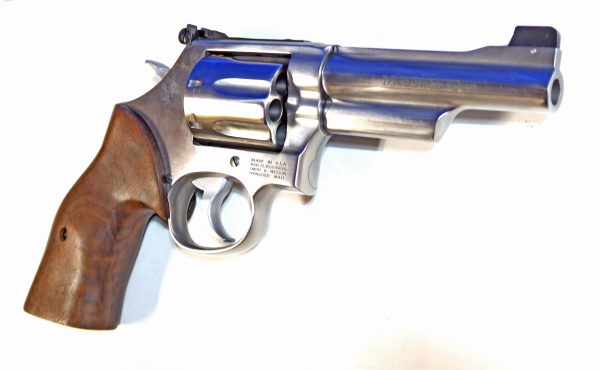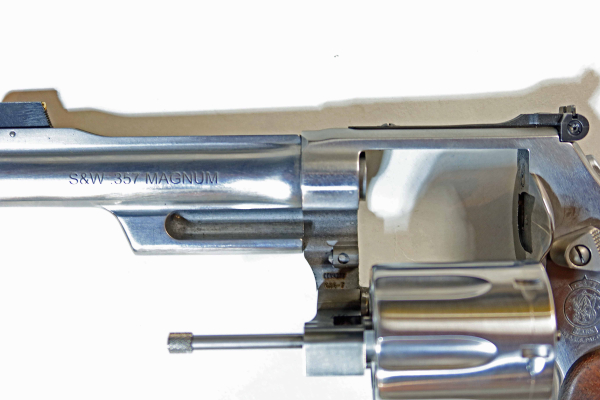I didn’t need a 44 Magnum. Out here, there may be some dangerous critters but they’re not the type requiring that level of power. When the new S&W Mountain Gun line of revolvers came out, I was happy to see a 357 Magnum among them – and, later, a 22 LR version in the M617 Mountain Gun.

The new 357 Mountain Gun is a Model 686 – that’s the “L” medium frame, a step above the 38 Special frame, the “K.” It’s a 686+, meaning there’s a seven-shot cylinder. I like that approach.
The gun features a four-inch skinny barrel, except it’s not skinny in the classic sense. It’s more substantial than earlier S&W revolver barrels. The front sight features a gold bead, a nice touch. As a 686, it’s fabricated from stainless steel and it features a modern iteration of Bear Hug “Grips” from Tyler Gun Works.
The MSRP isn’t cheap, at nearly $1,200, but it’s not a cheap gun. And it’s a modern S&W revolver with a ball detent lockup, a reinforced forcing cone and no unsightly lock hole over the cylinder latch. Along with being a lot easier to carry, it’s brisker when fired with rhino roller ammo.
At 35 ounces, its weight class is more M19 Combat Magnum territory than the classic underlugged M686 “Distinguished Combat Magnum.” Built for carry, it’s ideal in a belt holster, like the Galco Masterbilt Revenger Belt Holster.
The enhancements include greater durability and handling touches.
The four-inch tapered barrel is a one-piece barrel, a classic touch that’s harder to fit and “clock.” Like most current S&W revolvers, it’s a round-butt frame – but the stocks make it fit like a square butt in your hand. Speaking of stocks, they’re nicely made from walnut by Tyler Gun Works. The front sight is pinned in – why you’d ever change it is beyond me, but you could. It measures at .125,” nestled into the .140” black square notch of the adjustable rear sight.
The front of the cylinder has the “black powder bevel,” making it slick into the holster. The narrow hammer and (smooth-faced) narrow trigger are both flash chromed.
I set up the Ransom Master Rest and brought out three loads procured specifically for this revolver test. They were all from Hornady. The first load was the American Gunner 125 grain XTP. A round more typical for 357 Magnum lever action rifles – with tubular magazines – features the 140 grain FTX, in Hornady’s LeverEvolution line. Finally, the Backcountry Defense load – a new offering to my experience. The projectile is the 165 grain DGH (Dangerous Game Handgun) bullet, said to provide “… maximum penetration and no deflection …” It’s a jacketed pill, with the jacket open at the nose.

The first question one would expect is “do the stocks hurt or help?” The answer is “it’s a Magnum.” What do you expect?
The first load I shot had the lightest bullet. That would be less punishing, right? Lighter bullet and “every action has an equal and opposite reaction” or something – The American Gunner 125 grain XTP averaged 1,468 fps. Now that’s not bad. The first group fired was hampered by an elderly tripod under the Master Rest and one leg not holding up its side. At that, the five-inch group at 25 yards was jarring. The rig held up for three of the hits in 3 5/8”. Another group, with the rest on the bench, put all rounds under three inches.

But it’s rock-and-roll in the 35-ounce light Mountain Gun. The LeverEvolution generated 1,363 fps average and was noticeably easier to shoot. The 2 ¾” extreme spread held three rounds in 1 3/8”. The Backcountry Defense load – with the heaviest pill – gave an average velocity of 1,176 fps. Five hits went into 3 ½”, with three crowding into 2 ¾”.
I wanted to ensure that the gun was getting a fair shake and I benched the M617 Mountain Gun – a proven shooter – on the benched Master Rest. Five rounds of Winchester 36 grain plated 22LR ammo produced 1,088 fps and a 2 3/8” group.
The best three hits were in 5/8”.
That was a fluke, but it proved the rest and shooter could stay on the backstop.
On a later, 36°F and breezy morning trip to the range, I shot some ancient S&W branded 357 Magnum ammo received in a trade and some new Fiocchi 357 Magnum ammo. The S&W load was the S357HP3 158 grain JHP. It averaged 1,168 fps over the Garmin Xero C1 Pro chronograph and posted a 2 ¾” group, two-handed unsupported from fifteen yards. The Fiocchi 142 grain FMJ-TC load, rated at 1,420 fps, gave us 1,123 fps in the four-inch S&W barrel. Five shots went into four inches, courtesy of a shooter-induced flier. Four rounds went into 2 ¼”, with three hits into an inch.

I found I couldn’t stay on the B-8 repair center at 25 yards on that cold morning trip when shooting one-handed, though all hits were -1 and better on the IDPA target I used for a backer. Shooting the Hickok “Shootist Challenge” as I did with the M617 22 version of this gun (here), I induced one flier, last round fired – and I felt it go out. A pair of hits almost-nicked the top of the “postage stamp” graphic, but didn’t break the line. Five out of six hits were in a fair group for a cold old-timer from 30 feet one-handed.
So do you need a durable, high dollar, light Magnum? What is the utility?
If you’re carrying more than shooting – especially if you’re afoot – working on the farm or the ranch, for example, it’s a very handy choice. And it’s a classy looking handgun.
If you’re shooting lots of high intensity Magnum ammo you could get another revolver.
Or you could simply change stocks for the shooting excursion. For me, I’d invest in some ammo from High Desert CartridgeCompany, the 357 Magnum “DB” load (a 158-grain projectile at just over 900 fps). That would solve the problem of discomfort at the shooting end while providing all the horse-power I’d need in this part of the country. A 125-grain load at under 1,100 fps with a Hornady XTP bullet would be great too.
For me, it’s a carry-a-lot, shoot-as-needed utility revolver.
— Rich Grassi